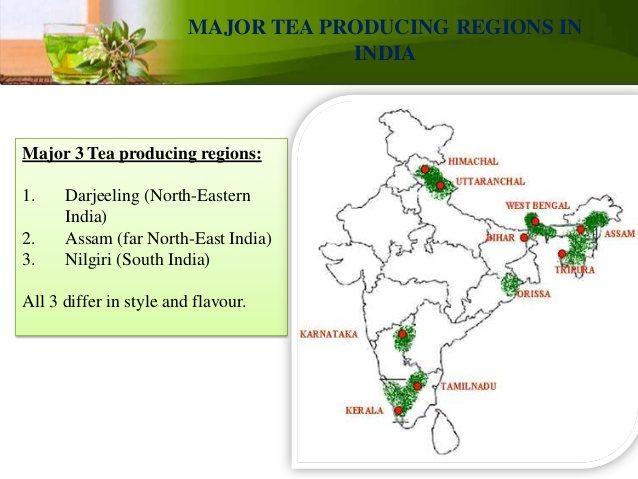Tea plantation in India was started in 1823 when wild leaf plants were discovered by the British in the forest of Assam. Commercial production of tea was started by the British East India Company.
Maniram Dewan (1806-1858) was the first Indian tea planter and is credited with establishing the first commercial plantations of the Assamese variety of tea. Tea production, certification, exportation, and all other facets of the tea trade in India is controlled by the Tea Board of India.

India is ranked second among the largest tea producing countries in the world, next only to China. More than 70% of tea is consumed in India itself.
The major tea-producing states in India are Assam, West Bengal, Tamil Nadu, Kerala, Tripura, Arunachal Pradesh, Himachal Pradesh, Karnataka, Sikkim, Nagaland, Uttarakhand, Manipur, Mizoram, Meghalaya, Bihar, Orissa.
Assam
Assam is the world’s largest producer of tea. Assam produces almost half of the total tea produced in India. The tea-producing region lies on either side of the Brahmaputra River. The daytime temperature rises to about 36 °C, creating greenhouse-like conditions of extreme humidity and heat. This tropical climate contributes to Assam’s unique malty taste, a feature for which this tea is well known. Assam Tea is a black tea named after the region of its production.
Historically, Assam has been the second commercial tea production region after southern China. Southern China and Assam are the only two regions in the world with native tea plants.
The main districts producing tea are Lakhimpur, Kamrup, Sivasagar, Goalpara, Cachar, Derrang and Nagaon.
West Bengal
West Bengal state ranks next to Assam in the list of tea-producing states in India. It accounts for more than 25 per cent of the tea produced in India.
The main districts producing tea are Darjeeling, Jalpaiguri and Coochbehar.
The Darjeeling tea is famous for its flavour and it is grown on the mountain slopes of the Himalayas at elevations ranging from 300 to 1800 meters.
North India
- Himachal Pradesh (Kangra and Nandi districts)
- Uttarakhand (Dehra Dun district)
- Jharkhand (Ranchi district)
- Arunachal Pradesh
- Tripura
- Manipur
- Meghalaya
South India
Tamil Nadu is the third-largest producer of Tea in India. Tea is grown on the hilly slopes of the Nilgiris and Palais in the states of Tamil Nadu, Karnataka, and Kerala.
The main districts producing tea in Tamil Nadu: Kanyakumari, Tirunelveli, Madurai, Coimbatore, Nilgiris
The main districts producing tea in Kerala: Cannanore, Palghat, Kozhikode, Malappuram, Trichur, Trivandrum, Quilon, Kottayam, Ernakulam, Idukki, Wayanad. Kerala’s beautiful Hill Station – Munnar, is the home of India’s largest tea plantations. There are around 50+ tea estates in and around Munnar. Most of them belong to the TATA Group.
The main districts producing tea in Karnataka: Chikmagalur, Coorg,


Leave a comment